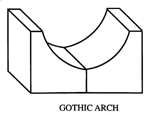Bal-tec™ Home Cathedral Arch
The Cathedral Arch

One of the often mentioned, but very seldom exploited Kinematic couples is the Cathedral or Gothic arch. This pair of off axis cylindrical or elliptical surfaces cradling a sphere has theoretically excellent properties.
Contoured Grinding Wheel
The only conventional way of producing this complex form as a monolith is to grind it with a contoured grinding wheel. The problem here is that the lay of this ground surface is at right angles to the linear axis of the Kinematic couple. The functional quality of this device will be directly limited by any lack of perfection in the form and surface texture of the contour that is, dressed on to the grinding wheel.
To add to the problem, this more complex, more expensive cathedral arch design wouldn't ever be considered except in a case of exceptional need. This means situations requiring a high load carrying capacity in a small envelope, or one requiring an exceptionally high resonate frequency. In order to achieve these extraordinary results, an exotic raw material with very high stiffness is required for the cathedral arch. A diamond grinding wheel is required to cut any and all of these exotic high performance materials and dressing an intricate form on a diamond abrasive grinding wheel produces limited accuracy.
The choice of materials falls into a very narrow range of sapphire, silicon carbides, ceramics and cemented metallic carbides, based mainly on their extreme stiffness. Cemented tungsten carbide is the toughest of these materials, it is readily available, and it is electrically conductive, so it can be economically processed by Electrical Discharge Machining. This makes it the best choice among these materials.
You may ask why not wire E.D.M. the form or even die sink it? Tungsten carbide is a non-conducting ceramic. When you E.D.M. it, you basically burn out the cobalt binder and the T.C. particles fall out leaving a severely eroded surface that is not at all suitable for Kinematic couplings. Any attempt to polish this eroded complex geometric surface will result in a loss of geometry and therefore repeatability.
Like many other problems, an urgent need is the mother of a good solution. By producing a blank in the form of a cube, with an oversize hole (this is a diameter much larger than the mating sphere) going thru it, the task is begun. The next, step is to grind and lap this oversized cylindrical hole to produce an excellent geometry and surface quality. The blank is then cut in half. The next step is to remove a section from the center of the remaining halves. The two pieces are now rejoined to form the arch.
Although a monolith is the preferred design, the impractability of production leaves us with this two-piece version. By burying the two pieces in a close fitting trench in the platform and fixing them there with an extreme strength ceramic filled epoxy glue, we end up with a very acceptable design that isn't exceptionally expensive. An alternative joining technique would be to braze the two pieces to a substrate.
